CBSE 10th Standard Science Subject Magnetic Effects of Electric Current Chapter Case Study Questions With Solution 2021
By QB365
QB365 Provides the updated CASE Study Questions for Class 10 , and also provide the detail solution for each and every case study questions . Case study questions are latest updated question pattern from NCERT, QB365 will helps to get more marks in Exams
QB365 - Question Bank Software
CBSE 10th Standard Science Subject Magnetic Effects of Electric Current Case Study Questions With Solution 2021
10th Standard CBSE
-
Reg.No. :
Science
-
An insulated copper wire wound on a cylindrical cardboard tube such that its length is greater than its diameter is called a solenoid. When an electric current is passed through the solenoid, it produces a magnetic field around it. The magnetic field produced by a current-carrying solenoid is similar to the magnetic field produced by a bar magnet. The field lines inside the solenoid are in the form of parallel straight lines. The strong magnetic field produced inside a current-carrying solenoid can be used to magnetise a piece of magnetic material like soft iron, when placed inside the solenoid. The strength of magnetic field produced by a current carrying solenoid is directly proportional to the number of turns and strength of current in the solenoid.
(i) The strength of magnetic field inside a long current -carrying straight solenoid is
(a) more at the ends than at the centre
(b) minimum in the middle
(c) same at all points
(d) found to increase from one end to the other.
(ii) The north-south polarities of an electromagnet can be found easily by using(a) Fleming's right-hand rule (b) Fleming's left-hand rule (c) Clock face rule (d) Left-hand thumb rule (iii) For a current in a long straight solenoid N-and S-poles are created at the two ends.
Among the following statements, the incorrect statement is
(a) The field lines inside the solenoid are in the form of straight lines which indicates that the magnetic field is the same at all points inside the solenoid.
(b) The strong magnetic field produced inside the solenoid can be used to magnetise a piece of magnetic material like soft iron, when placed inside the coil.
(c) The pattern of the magnetic field associated with the solenoid is different from the pattern of the magnetic field around a bar magnet.
(d) The N- and S-poles exchange position when the direction of current through the solenoid is reversed.
(iv) A long solenoid carrying a current produces a magnetic field B along its axis. If the current is double and the number of turns per cm is halved, then new value of magnetic field is(a) B (b) 2B (c) 4B (d) B/2 (v) A soft iron bar is enclosed by a coil of insulated copper wire as shown in figure. When the plug of the key is closed, the face B of the iron bar marked as

(a) N-pole (b) S-pole (c) N-pole if current is large (d) S-pole if current is small (a) -
A magnetic field is described by drawing the magnetic field lines. When a small north magnetic pole is placed in the magnetic field created by a magnet, it will experience a force. And if the north pole is free, it will move under the influence of magnetic field. The path traced by a north magnetic pole free to move under the influence of a magnetic field is called a magnetic field line. Since the direction of magnetic field line is the direction of force on a north pole, so the magnetic field lines always begin from the N-pole of a magnet and end on the S-pole of the magnet. Inside the magnet, however the direction of magnetic field lines is from the S-pole of the magnet to the N-pole of the magnet. Thus, the magnetic field lines are closed curves. When a small compass is moved along a magnetic field line, the compass needle always sets itself along the line tangential to it. So, a line drawn from the south pole of the compass needle to its north pole indicates the direction of the magnetic field at that point.
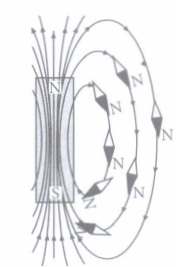
(i) The magnetic field lines
(a) intersect at right angle to one another
(b) intersect at an angle of 45° to each other
(c) do not cross one another
(d) cross at an angle of 60° to one another.
(ii) A strong bar magnet is placed vertically above a horizontal wooden board. The magnetic lines of force will be
(a) only in horizontal plane around the magnet
(b) only in vertical plane around the magnet
(c) in horizontal as well as in vertical planes around the magnet
(d) in all the planes around the magnet.
(iii) Magnetic field lines can be used to determine
(a) the shape of the magnetic field
(b) only the direction of the magnetic field
(c) only the relative strength of the magnetic field
(d) both the direction and the relative strength of the magnetic field.
(iv) The magnetic field lines due to a bar magnet are correctly shown in figure

(v) Which of the following is not true about magnetic field lines?
(a) Magnetic field lines are the closed and continuous curve.
(b) No two field lines can cross each other.
(c) Crowdness of field lines represents the strength of magnetic field.
(d) The direction of field lines is from the north pole to the south pole inside a bar magnet.(a) -
Andre Marie Ampere suggested that a magnet must exert an equal and opposite force on a current carrying conductor, which was experimentally found to be true. But we know that current is due to charges in motion. Thus, it is clear that a charge moving in a magnetic field experience a force, except when it is moving in a direction parallel to it. If the direction of motion is perpendicular to the direction of magnetic field, the magnitude of force experienced depends on the charge, velocity (v), strength of magnetic field (B), and sine of the angle between v and B. Direction of magnetic force is given by Fleming's left hand rule.
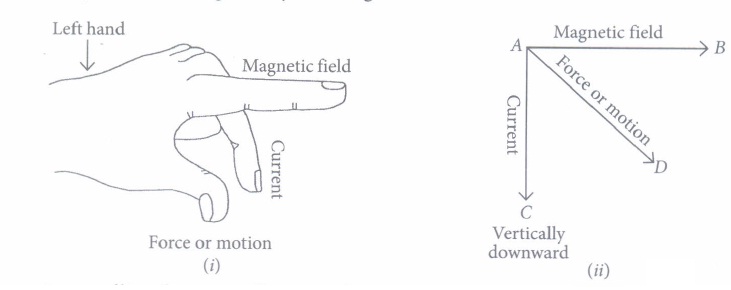
(i) If an electron is travelling horizontally towards east. A magnetic field in vertically downward direction exerts a force on the electron along(a) east (b) west (c) north (d) south (ii) If a charged particle is moving along a magnetic field line. The magnetic force on the particle is
(a) along its velocity (b) opposite to its velocity (c) perpendicular to its velocity (d) zero (iii) A magnetic field exerts no force on
(a) a stationary electric charge
(b) a magnet
(c) an electric charge moving perpendicular to its direction
(d) an unmagnetised iron bar
(iv) A uniform magnetic field exists in the plane of paper pointing from left to right as shown in figure. In the field an electron and a proton move as shown. The electron and the proton experience
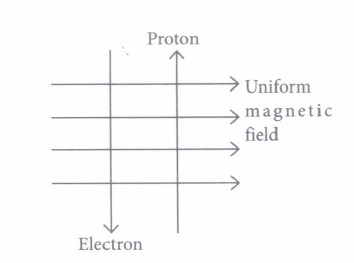
(a) forces both pointing into the plane of paper
(b) forces both pointing out of the plane of paper
(c) forces pointing into the plane of paper and out of the plane of paper, respectively
(d) force pointing opposite and along the direction of the uniform magnetic field respectively
(v) An electron beam enters a magnetic field at right angles to it as shown in the figure. The direction of force acting on the electron beam will be
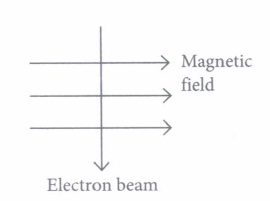
(a) to the left (b) to the right (c) into the page (d) out of the page (a) -
A current carrying wire produces magnetic field around it. The phenomena in which an electromotive force and current (if the conductor is in the form of a closed circuit) is induced by changing magnetic field (or by passing magnetic field lines) through it is called electromagnetic induction. The emf so developed is called induced emf and current made to flow is called induced current. The cause of induced emf carried out by Faraday and Henry. It can be concluded that the induced current flows in a conductor as long as the magnetic lines of force change within the conductor. In case of relative motion i.e., motion of coil w.r.t to magnet or vice versa, the direction of the current flowing in the conductor is determined by the direction of the relative motion of the conductor with respect to the magnetic field. The induced emf or current is directly proportional to the rate of change in magnetic field.
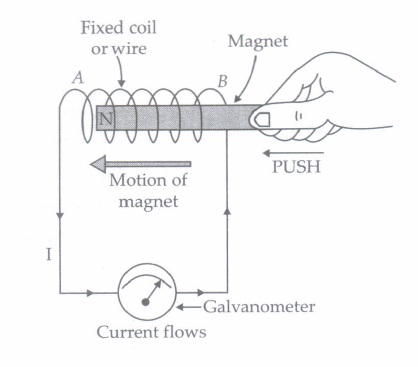
(i) A student connects a coil of wire with a sensitive galvanometer as shown in figure. He will observe the deflection in the galvanometer if bar magnet is
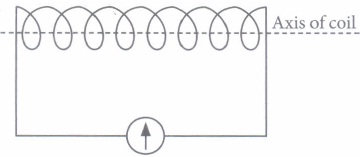
(a) placed near one of the faces of the coil and parallel to the axis of the coil
(b) placed near one of the faces of the coil and perpendicular to the axis of the coil
(c) placed inside the coil
(d) moved towards or away from the coil parallel to the axis of the coil.
(ii) A conducting rod AB moves across two magnets as shown in figure and the needle in the galvanometer deflects momentarily. What is the name of this physical phenomenon?
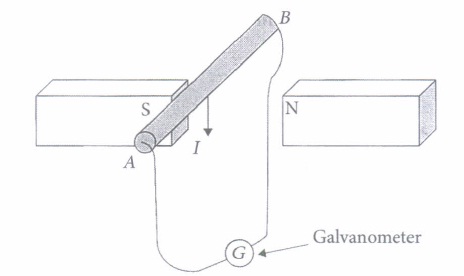
(a) Electromagnetism (b) Induced magnetism (c) Electromagnetic induction (d) Static induction (iii) A bar magnet is pushed steadily into a long solenoid connected to a sensitive meter.
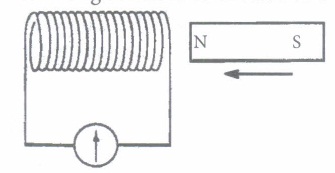
Which of the following would affect the magnitude of the deflection of the meter?
(a) How fast the magnet is pushed into the coil.
(b) The direction in which the coil is wound.
(c) The end of the solenoid the magnet enters.
(d) The pole of the magnet enters the coil first.
(iv) What is the condition of an electromagnetic induction?
(a) There must be a relative motion between galvanometer and coil of wire.
(b) There must be a relative motion between galvanometer and a magnet.
(c) There must be a relative motion between galvanometer and electric motor.
(d) There must be a relative motion between the coil of wire and a magnet.
(v) An induced emf is produced when a magnet is plunged into a coil. The magnitude of induced emf does not depend on(a) the number of turns in the coil (b) the speed with which the magnet is moved (c) the strength of the magnet (d) the resistivity of the material of the coil (a) -
An electric motor is a rotating device that converts electrical energy into mechanical energy. Electric motor is used as an important component in electric fans, refrigerators, mixers, washing machines, computers, MP3 players, etc.
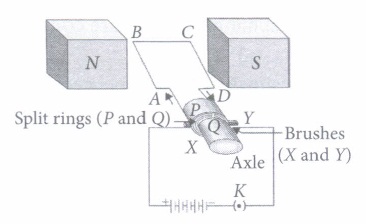
An electric motor consists of a rectangular coil ABCD of insulated copper wire. The coil is placed between the two poles of a magnetic field such that the arm AB and CD are perpendicular to the direction of the magnetic field. The ends of the coil are connected to the two halves P and Q of a split ring. The inner sides of these halves are insulated and attached to an axle. The external conducting edges of P and Q touch two conducting stationary brushes X and Y respectively, as shown in the figure. Commercial motors use an electromagnet in place of a permanent magnet, a large number of turns of conducting wire in the current carrying coil and a soft iron core on which the coil is wound.
(i) Choose incorrect statement from the following regarding split rings.
(a) Split rings are used to reverse the direction of current in coil.
(b) Split rings are also known as commutator.
(c) Split ring ii a discontinuous or a broken ring.
(d) Both (a) and (b)
(ii) Which of the following has no effect on the size of the turning effect on the coil of an electric motor?(a) The amount of the current in the coil (b) The direction of the current in the coil. (c) The number of turns in the coil. (d) The strength of the magnetic field (iii) When current is switched ON, an electric fan converts
(a) mechanical energy to chemical energy (b) electrical energy to mechanical energy (c) chemical energy to mechanical energy (d) mechanical energy to electrical energy. (iv) In an electric motor, device that makes contact with the rotating rings and through them to supply current to coil is
(a) axle (b) brushes (c) coil (d) split rings. (v) In an electric motor, the direction of current in the coil changes once in each
(a) two rotations (b) one rotation (c) half rotation (d) one-fourth rotation (a)


















